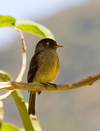Genus Empidonax

Pine Flycatcher - The Pine Flycatcher is a species of bird in the Tyrannidae family, the tyrant flycatchers. It is found in the montane tropical and subtropical coniferous forests of Mexico and southwestern Guatemala.
Flycatcher - Adults have olive-brown upperparts, browner on the wings and tail, with whitish underparts; they have a white eye ring, white wing bars, a small bill and a short tail. The breast is washed with olive-grey. The upper part of the bill is grey; the lower part is orangish. At one time, this bird was included with the very similar Willow Flycatcher in a single species, "Traill's Flycatcher".
Black-capped Flycatcher - This species is found in the high canopy of mountain oak forest, coming lower at the edges and in clearings, and also in second growth and bushy pastures. It breeds mainly in the highest forested areas, from 2450 m to 3300 m altitude, but will descend to as low as 1850 m in the height of the rainy season.
Western Flycatcher - In plumage, the Pacific-slope Flycatcher is virtually identical to the Cordilleran Flycatcher, and differs only subtly from most Empidonax flycatchers in North America, but its breeding habitat and call are different. In summer, the Pacific-slope Flycatcher inhabits deciduous or mixed woodlands, hawking for insects from a hidden perch.
Yellowish Flycatcher - This species is found in cool mountain forest, especially at the edges and in clearings, and in second growth and bushy pastures. It breeds from 800 m to nearly 2500 m altitude. The deep cup nest is made of plant fibre and mosses, and placed 2–4.5 m high in a crevice in a tree trunk or earth bank. The typical clutch is two or three white eggs, marked with pale rufous speckles. Incubation by the female is 14–15 days to hatching, with another 17 days to fledging.
Yellow-bellied flycatcher - Adults have brownish-olive upperparts, darker on the wings and tail, with yellowish underparts; they have a white eye ring, white wing bars, a small bill and a short tail. The upper part of the bill is dark; the lower part is orange-pink.
Buff-breasted flycatcher - Adults have olive gray upperparts, and darker coloration on the wings and tail; they have a conspicuous white eye ring, white wing bars, a small bill and a short tail. The breast of this species is very distinctive, washed with a strong orange buff color.
Hammond's flycatcher - Adults have greyish-olive upperparts, darker on the wings and tail, with whitish underparts; they have a conspicuous white eye ring, white wing bars, a small bill and a short tail. The breast is washed with grey and the sides of the belly with yellow. Many species of Empidonax flycatchers look closely alike. The best way to distinguish species is by voice, by breeding habitat and/or range.
Least Flycatcher - Adults have greyish-olive upperparts, darker on the wings and tail, with whitish underparts; they have a conspicuous white eye ring, white wing bars, a small, short bill and a short tail. The breast is washed with grey and the sides of the belly with yellow. It is similar in appearance to the larger Eastern Wood Pewee.
Dusky flycatcher - Adults have olive-grey upperparts, darker on the wings and tail, with whitish underparts; they have a noticeable medium-width white eye ring, white wing bars and a medium length tail. The breast is washed with olive-grey. The bill is mainly dark. It is a bit smaller than the Gray Flycatcher and a bit larger than the Hammond's Flycatcher.
Western Flycatcher - Adults have olive-gray upperparts, darker on the wings and tail, with yellowish underparts; they have a conspicuous teardrop-shaped white eye ring, white wing bars, a small bill and a short tail. Many species of this genus look closely alike. The best ways to distinguish species are by voice, by breeding habitat, and by range. This bird is virtually identical to the Pacific-slope Flycatcher. These two species were formerly considered a single species known as Western Flycatcher. The Pacific-slope is a breeding bird of the Pacific Coast forests and mountain ranges from California to Alaska; the Cordilleran is a breeding bird of the Rocky Mountains. They have different songs and calls.
Willow Flycatcher - Adults have brown-olive upperparts, darker on the wings and tail, with whitish underparts; they have an indistinct white eye ring, white wing bars and a small bill. The breast is washed with olive-grey. The upper part of the bill is grey; the lower part is orangish. At one time, this bird and the Alder Flycatcher were considered to be a single species, Traill's Flycatcher.
Acadian Flycatcher - Adults have olive upperparts, darker on the wings and tail, with whitish underparts; they have a white eye ring, white wing bars and a wide bill. The breast is washed with olive. The upper part of the bill is dark; the lower part is yellowish.
Gray flycatcher - The Gray Flycatcher is one of many species in the genus Empidonax. These species are very similar in appearance and behavior, and they are notoriously difficult to differentiate. The best characteristics for distinguishing these species are voice, breeding habitat, and range. The Gray Flycatcher, however, can be identified by a unique behavior, its downward tail wag. Other Empidonax species typically exhibit a rapid upward tail flick.



